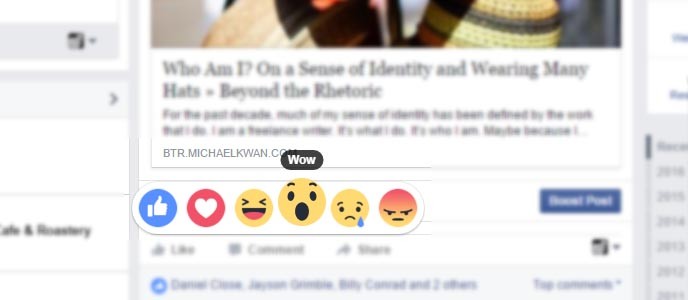After so many years of the iconic thumbs-up “like” button that came to be synonymous with the popular social network, Facebook finally expanded the “like” button into a series of six “reactions.” Yes, people could always post longer comments and these comments could even involve uploaded images, but the simplicity and instantaneous nature of the “like” button made it the most common way for people to interact with a post on Facebook.
The Sensational Six
In addition to the “like” button, users can hover their mouse pointer (or long press on mobile) to reveal the love, haha, wow, sad and angry “reactions” too.

To some people, this change is largely inconsequential. Big deal, right? Instead of someone saying that they simply “like” something that you posted on Facebook, they can now choose to say that they “love” it instead. From the perspective of an online business or an Internet marketer, you just want to get as much engagement and reach as possible, right?
That’s partly true, but there is something much more to this that should be getting your attention. This is in addition to the ability to see, on an individual post basis, how your fans and friends are “reacting” to your posts. You can see how many people reacted with a haha or how many people reacted with a sad face. That’s good and it could be useful, but that’s not the biggest reason why you should care about these new reactions on Facebook.
A Deeper Level of Engagement
It’s the fact that you can now see how many people are going through the extra effort of either hovering over the like button or holding down the like button on mobile in order to reveal the reactions pop-up. Realistically, it doesn’t matter all that much whether someone chose the “wow” or the “haha” to react to your post; what matters is that they didn’t just choose the generic “like” instead.
In order to “like” a post, people just do what they’ve always been doing. They can scroll through their feed quickly, tap the like button and move on to the next item. In order to react with a “sad” face, they have to stop, hold, wait, and then choose the “reaction” they want to use. The higher barrier to entry here cannot and should not be ignored.
The next several weeks or months will still be a transition period, because a lot of people may not yet be familiar with Facebook “reactions” and they might not use them just yet. They might not know how or they might not know what they mean. Once they become as ingrained as the regular “like” button, though, you should pay much closer attention to whether people are just “liking” your content or if they are “reacting” to it with one of the alternatives.
Chances are that if you are seeing more reactions, it means that you are producing content that is eliciting a stronger reaction from your fans and friends. If you are only getting likes (or no reactions at all), maybe you need to spend more time on developing more engaging content. Because if they’re not engaged, they’re not nearly as interested in what you have to say (or sell).
Where’s the Thumbs Down?
As of this writing, there is still no “dislike” button on Facebook. Whether that makes you sad, angry or have any other kind of reaction, maybe it’s happiest for your ego that your friends can’t dislike what you post. It’s probably good for your brand too, even if haters gotta hate.
